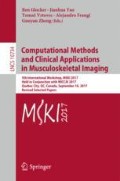Abstract
To evaluate spinal deformities, the Cobb angle is the main diagnostic parameter that is usually measured on two-dimensional coronal radiographic (X-ray) images. In this paper, we propose a method for the evaluation of the three-dimensional (3D) Cobb angle from 3D spine mesh models with varying face-vertex density. For the upper-end and lower-end vertebra mesh models, the location of the vertebral body center and mesh faces that belong to the vertebral body surface are identified by unsupervised classification of mesh faces of the vertebral body, which serve only as training data, and subsequent supervised classification of all mesh faces. Adjacent mesh faces are then labeled with the same class, and after comparison to mesh faces in the training data, we label the mesh faces of the superior and inferior vertebral endplate. Finally, planes are fitted to the superior endplate of the upper-end vertebra and the inferior endplate of the lower-end vertebra, which define the 3D Cobb angle. The method was tested on 60 triangular mesh models of the scoliotic spine, and each mesh model was generated at 17 different face-vertex densities. For meshes with the mean face edge length below 6 mm, the proposed method was accurate, with the mean absolute error of \(3.0^\circ \) and the corresponding standard deviation of \(2.2^\circ \) when compared to reference measurements.
Access this chapter
Tax calculation will be finalised at checkout
Purchases are for personal use only
References
Stedman’s Medical Dictionary. http://www.medilexicon.com/dictionary/80286. Accessed 4 June 2017
Cobb, J.: Outline for the study of scoliosis. Am. Acad. Orthop. Surg. Instr. Course Lect. 5, 261–275 (1948)
Vrtovec, T., Pernuš, F., Likar, B.: A review of methods for quantitative evaluation of spinal curvature. Eur. Spine J. 18(5), 593–607 (2009)
Trobisch, P., Suess, O., Schwab, F.: Idiopathic scoliosis. Dtsch. Arztebl. Int. 107(49), 875–884 (2010)
Huo, X., Tan, J., Qian, J., Cheng, L., Jing, J., Shao, K., Li, B.: An integrative framework for 3D Cobb angle measurement on CT images. Comput. Biol. Med. 82, 111–118 (2017)
Štern, D., Likar, B., Pernuš, F., Vrtovec, T.: Automated detection of spinal centrelines, vertebral bodies and intervertebral discs in CT and MR images of lumbar spine. Phys. Med. Biol. 55(1), 247–264 (2010)
Bresenham, J.: Algorithm for computer control of a digital plotter. IBM Syst. J. 4(1), 25–30 (1965)
Arthur, D., Vassilvitskii, S.: \(k\)-means++: the advantages of careful seeding. In: Proceedings of 18th Annual ACM-SIAM Symposium on Discrete Algorithms - SODA 2007, pp. 1027–1035. SIAM (2007)
Fischler, M., Bolles, R.: Random sample consensus: a paradigm for model fitting with applications to image analysis and automated cartography. Commun. ACM 24(6), 381–395 (1965)
Kadoury, S., Cheriet, F., Laporte, C., Labelle, H.: A versatile 3-D reconstruction system of the spine and pelvis for clinical assessment of spinal deformities. Commun. ACM 45(6), 591–602 (2007)
Kadoury, S., Cheriet, F., Labelle, H.: Personalized X-ray 3-D reconstruction of the scoliotic spine from hybrid statistical and image-based models. IEEE Trans. Med. Imaging 28(9), 1422–1435 (2009)
Masharawi, Y., Salame, K., Mirovsky, Y., Peleg, S., Dar, G., Stemberg, N., Hershkovitz, I.: Vertebral body shape variation in the thoracic and lumbar spine: characterization of its asymmetry and wedging. Clin. Anat. 21(1), 46–54 (2008)
Acknowledgements
This work was supported by the Slovenian Research Agency under grants P2-0232, J2-5473, J7-6781 and J2-7118.
Author information
Authors and Affiliations
Corresponding author
Editor information
Editors and Affiliations
Rights and permissions
Copyright information
© 2018 Springer International Publishing AG
About this paper
Cite this paper
Petković, U., Korez, R., Parent, S., Kadoury, S., Vrtovec, T. (2018). 3D Cobb Angle Measurements from Scoliotic Mesh Models with Varying Face-Vertex Density. In: Glocker, B., Yao, J., Vrtovec, T., Frangi, A., Zheng, G. (eds) Computational Methods and Clinical Applications in Musculoskeletal Imaging. MSKI 2017. Lecture Notes in Computer Science(), vol 10734. Springer, Cham. https://doi.org/10.1007/978-3-319-74113-0_5
Download citation
DOI: https://doi.org/10.1007/978-3-319-74113-0_5
Published:
Publisher Name: Springer, Cham
Print ISBN: 978-3-319-74112-3
Online ISBN: 978-3-319-74113-0
eBook Packages: Computer ScienceComputer Science (R0)

